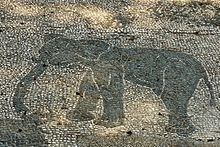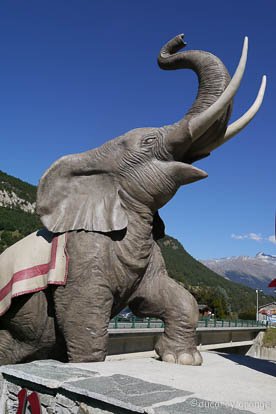RE: One Bit News - Crypto Zoology - Week 3
The elephant of the Atlas (Morocco) :
The elephant of the Atlas, formerly a tame and domesticated species, no longer exists today. It is supposed that it was these animals that allowed Hannibal and his Carthaginians to cross the Alps in 219 BC.

The elephant of North Africa (Loxodonta pharaoensis or Loxodonta cyclotis pharaoensis or Loxodonta africana pharaoensis), is an elephant disappeared today which fed the troops of Carthage in elephants of war during the Roman antiquity. A possible subspecies of the African savannah elephant or the African forest elephant or a full species of the genus Loxodonta, the North African elephant is not recognized by taxonomy.
Ancient writers, especially Polybius and Appian, mention the presence of war elephants in the Punic armies. Elephants are reported in North Africa, particularly in the eastern part of Tingitane, by Pliny the Elder (V, 18) and Herodotus (IV, 191) in particular. They were found especially at the foot of the Atlas and in the region of Cape Soloeis, in the vicinity of the columns of Hercules, the Strait of Gibraltar.
Ancient traces
Numidia would have hosted it according to Pliny the Elder (V, VIII, 31) and Polybius (XII, 3, 5). Appian (African book, IX, 34) states that when the Carthaginians learned that Scipio the African was preparing to go to Africa, they sent Hasdrubal to drive the elephant in Numidia. Pliny the Elder describes the North African elephant as an animal capable of withstanding the thirst and ardor of the sun in the deserts of Libya where the Garamantes gave chase, ie to Fezzan. These indications prove that the elephants employed by Hannibal did not come from the East.
Climate change, hunting and their use in circus games have probably caused the gradual disappearance of elephants in North Africa.
Unlike the Asian elephant, which has a regularly convex back, the North African elephant had a characteristic silhouette with a saddle on the back of the head. Smaller than his Asian cousin, he did not exceed the 2.50m at the withers, a modest size that did not allow them to wear this tower which they are sometimes decked out on some paintings or drawings.

An elephant used as a weapon of war
The role of the fighting elephant was not negligible. He was the second animal, after the horse, used by Hannibal in his wars. It is even more often mentioned by historical sources. The Carthaginians have aligned a large number to carry out their various enterprises; 140 during the Second Punic War. By his formidable impact force for the enemy infantry lines, this animal gave Hannibal's infantry lines the solidity they lacked.
The elephants of the Atlas were protected by metal plates and they carried a bell designed to excite them in combat. This subspecies was decimated during the first century of the Roman conquest, a population survived the Sudan until the 19th century.
This was very interesting @Redouanemez
If you have more intersting cryptozoology animals from Morocco feel fre to post them here so we also can learn somthing new. Very good work.
Kidnest regards
@Gyldenhorn
for
@Onebitnews
Thank you,
Ok I will try to post more intersting cryptozoology animals from Morocco.
Best Regards,
@redouanemez